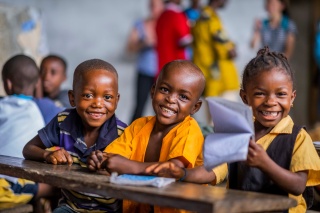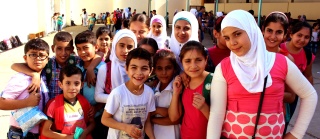
Establishing a new school feeding programme in four simple steps
Expanding our feeding programme in schools requires comprehensive research, planning and assessment from our programme teams.
With so many children across the world in need of daily meals in school, you might wonder how Mary’s Meals decides which countries, schools and partners to deliver our school feeding programme.
This article looks at some of the factors our teams take into account when deciding where and how to provide a daily meal for children in their place of education in the world’s poorest communities.

How we choose where to work
There are several factors we consider when it comes to where to expand our programme. The most important are need, partnership and opportunity.
We look at various indicators of hunger, food insecurity and access to primary education, as well as school feeding that may already exist in the region. We then ascertain our ability to reach children in these locations, including operational considerations, and the relationships and networks we have at local and national level. And we consider our experience of implementing school feeding in neighbouring countries in the region.
Finally, we also look at challenges related to weather and climate, and how prone the region is to drought and flooding, which can make schools increasingly vulnerable and more difficult to access.

How we decide which schools to target
We take a clustered approach to our feeding and include all schools that demonstrate a strong need within a particular area. This helps us guard against children migrating between schools, in terms of them moving between schools where one has a feeding programme and another does not.
Our local partners use our assessment tools to ensure we collect the necessary information to make informed decisions on school selection, enabling us to effectively target the right schools, in the right areas from the start. With our tools we can gather information on the type of school and the community's involvement, the existing school infrastructure (for operational and delivery purposes), and we can also start to build an idea of the level of need in each individual school.

How we choose our partners
We build local and national partnerships in a number of different ways. Sometimes they develop through a mutual contact or an appropriate organisation approaching us directly. In other cases, when we know we are interested in working in a particular location, we actively seek out organisations operating in the region.
We identify potential partners in a region by considering: does the partner’s approach match our values? Have they previously carried out school feeding? What areas do they open up for us to work in? And are they operating in an area of high need?
This is followed by a process of due diligence, where we ask the potential partner about their other operations, safeguarding policies, and various technical and legal aspects. This helps us get a feel for how they align with our values, especially in terms of a low-cost approach.
Once we’ve identified a new partner and created a formal agreement to work together, we collaborate to design an efficient and effective programme. This might include co-designing logistics, local supplier planning and delivery implementation. The partner provides the local expertise, while Mary’s Meals brings our decades of school feeding experience to the table.
Why the community is vital
Community engagement is critical for school feeding success, as we depend on volunteers in the community to prepare and deliver the meal each school day. We include this into our scoping of schools to ensure we are maximising the potential for programme success alongside committed communities. We also rely on the local network and expertise of our partner to effectively engage community members from the very beginning, and to flag any issues as they come up.
Many of the schools we reach have never had a school feeding programme before. But the feedback we get from the local community reminds us of the great need for our programme, but also the great joy that comes out of our mission.
We currently deliver a nutritious meal to over 2.4 million children in schools, providing hope and a brighter future for vulnerable families and communities. Your ongoing support helps us grow our movement, enabling us to reach the next hungry child waiting for Mary’s Meals.
Erin Pratley is our Director of Programme Development & Operations. She leads a team that supports our programme implementers to ensure daily delivery of Mary’s Meals, as well as innovating our programme and assessing the impact of our work.
It costs just £19.15, €22, $25.20 USD or $31.70 CAD to provide a child with school meals for an entire school year. Learn how your donation will make a difference.
